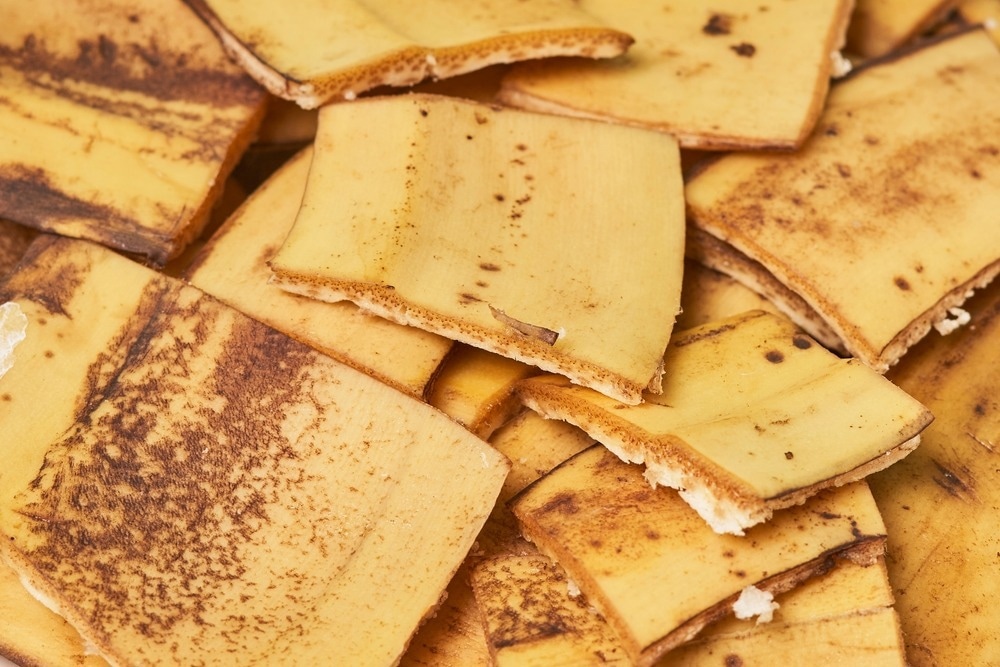Writing in the journal Sustainability, researchers from Universiti Teknologi Malaysia and Universiti Malaysia Sabah have reviewed current and future perspectives on the reuse of banana peel waste, a major agricultural waste stream.

Study: Methods and Potential in Valorization of Banana Peels Waste by Various Extraction Processes: In Review. Image Credit: G.Tbov/Shutterstock.com
Bananas and Banana Peel Waste: Historical and Current Uses
Bananas are a key agricultural product, with an excess of 114 million tons produced globally per year. Bananas are valued for their high nutritional properties as well as their digestibility. These tropical fruits are typically sold raw or incorporated into multiple snacks and other sweet food products.
Banana peel accounts for around 1/3 of the weight of this foodstuff and is commonly discarded as waste. The weight of banana peel waste produced per year worldwide is roughly 39.9 million tons.
Due to the antimicrobial and antioxidant properties of banana peel, it has historically been used to treat medical ailments such as burns, inflammation, ulcers, and diarrhea.
There is vast potential for the utilization of banana peel waste in the biomedical and nutraceutical industries.
Additionally, this key agricultural waste is commonly used as livestock feed for animals such as cows and buffalos. Due to adequate levels of potassium content, banana peel can be used as a domestic fertilizer.
Producing Pectin from Banana Peel Waste
Pectin is a soluble gelatinous polysaccharide that has many commercial applications. In banana peels, pectin accounts for around 9-22% of their total content. This compound possesses gelatinization, stabilization, and thickening properties.
Pectin is used in the textile, cosmetic, and food industries, performing many key functions during manufacturing. Currently, commercial pectin is derived from sources such as apple pomace and citrus peels. The high pectin content of banana peel waste makes it a potentially valuable commercial alternative to current food sources of this key industrial compound.
Conventional methods for extracting pectin include using Soxhlet combined with organic solvents and maceration. However, there are problems with conventional methods such as cost, the formation of toxic by-products, and the use of organic solvents themselves.
To overcome the current issues with extraction, green extraction methods have gained traction in recent years which negate the need for solvents, the production of harmful residues, and lower production costs.
Green methods could provide higher yields and product quality, significantly improving the extraction and commercial viability of commercial pectin production. Research is ongoing into technologies such as microwave-assisted extraction and subcritical water extraction. This area of study is still in its relative infancy and faces many challenges of its own.
The Paper
The main focus of the paper in Sustainability is the provision of information on historical and current perspectives on the extraction of high-quality and high-quantity commercial pectin from banana peel waste. Additionally, the authors have analyzed global commercial banana production as a source of this valuable waste product.
The latest banana peel pectin quality analysis studies have been highlighted in the paper, with the antimicrobial and antioxidant properties of the compound discussed in depth. Present extraction techniques are evaluated, and future perspectives have been presented.
Research Perspectives on Green Pectin Extraction from Banana Peel Waste
The current research into advanced green extraction methods has proved promising for the valorization of banana peel waste to produce commercial pectin. Whilst they have shown quantitative and qualitative value in laboratory-scale studies, currently, their industrial-scale applicability is hindered by a lack of knowledge.
Ultrasound, microwave, Soxhlet, and subcritical water methods have emerged as the most beneficial and innovative strategies, though with varying degrees of effectiveness. Their industrial-scale application is limited by lack of scalability, which currently favors continuous techniques.
Some of the current state-of-the-art methods for pectin extraction from banana peel waste have issues with cost-effectiveness, which may place them out of reach for new manufacturers. Operational parameter optimization is vital for improving these methods and making them more efficient and affordable.
Another challenge is the current lack of study on ultrasound and subcritical water methods, which is a significant research gap. This hinders the further development of these green extraction methods and must be addressed by future researchers.
Developing effective high-performance green extraction methods will help to improve the valorization of growing banana peel waste in line with the aims of the circular economy and provide new routes to commercial pectin production.
In Summary
The new paper reviews the current and future perspectives on valorizing banana peel waste for commercial pectin production. Providing key information on green extraction methods and an overview of current banana peel production worldwide, the study aims to provide future researchers with a knowledge base for further efforts in this field of study.
Thus, the study helps to improve the circularity of the banana industry, agriculture, banana peel waste production, and several industries that utilize pectin in a wide variety of commercial products.
More from AZoM: A to Z of Electromagnetic Shielding
Further Reading
Putra, N.H et al. (2022) Methods and Potential in Valorization of Banana Peels Waste by Various Extraction Processes: In Review Sustainability 14(17) 10571 [online] mdpi.com. Available at:
Disclaimer: The views expressed here are those of the author expressed in their private capacity and do not necessarily represent the views of AZoM.com Limited T/A AZoNetwork the owner and operator of this website. This disclaimer forms part of the Terms and conditions of use of this website.